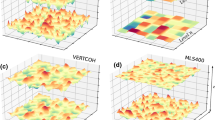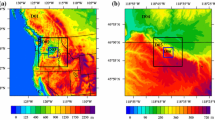Abstract
The grey zone of dry convection is the range of scales in which boundary-layer thermals are partly explicitly resolved by numerical weather prediction (NWP) models and partly parametrized. We seek to determine how thermals are divided into subgrid and resolved scales in the grey zone of convective boundary-layer thermals. Reference data for grid-scale and subgrid-scale fields at these resolutions are constructed by filtering 62.5-m large-eddy simulation data. A conditional sampling is adapted to detect subgrid thermals, and is used to characterize the subgrid thermals at several grid spacings in the grey zone. A mass-flux parametrization used in NWP models is compared with the subgrid thermal field. The analysis demonstrates that, although the mass-flux framework is suitable in the grey zone, some assumptions of the mass-flux schemes, usually used at the mesoscale, cannot be made in the grey zone. In particular, the thermal fraction is not small, the resolved vertical velocity is not negligible, the entrainment and detrainment rates depend on the horizontal resolution, the triggering and the closure at the surface are moreover random.










Similar content being viewed by others
References
Arakawa A, Jung J-H, Wu C-M (2011) Toward unification of the multiscale modeling of the atmosphere. Atmos Chem Phys 11:3731–3742
Arakawa A, Wu C-M (2013) A unified representation of deep moist convection in numerical modeling of the atmosphere. Part I. J Atmos Sci 70:1977–1992
Brown AR, Cederwall RT, Chlond A, Duynkerke PG, Golaz J-C, Khairoutdinov M, Lewellen DC, Lock AP, Macvean MK, Moeng C-H, Neggers RAJ, Siebesma AP, Stevens B (2002) Large-eddy simulation of the diurnal cycle of shallow cumulus convection over land. Q J R Meteorol Soc 128:1075–1093
Canut G, Couvreux F, Lothon M, Pino D, Said F (2012) Observations and large-eddy simulations of entrainment in the sheared sahelian boundary layer. Boundary-Layer Meteorol 142:79–101
Cheng A, Xu K-M, Stevens B (2009) Effects of Resolution on the simulation of boundary-layer clouds and the partition of kinetic energy to subgrid scales. J Adv Model Earth Syst 2:21. doi:10.3894/JAMES.2010.2.3
Clarke RH, Dyer AJ, Reid DG, Troup AJ (1971) The Wangara experiment: Boundary layer data. Division Meteorological Physics Paper, CSIRO 19: Australia
Couvreux F, Guichard F, Redelsperger J-L, Kiemle C, Masson V, Lafore J-P, Flamant C (2005) Water vapour variability within a convective boundary-layer assessed by large-eddy simulations and IHOP 2002 observations. Q J R Meteorol Soc 131:2665–2693
Couvreux F, Hourdin F, Rio C (2010) Resolved versus parametrized boundary-layer plumes. Part I: A parametrization-oriented conditional sampling in large-eddy simulations. Boundary-Layer Meteorol 134:441–458
Craig GC, Cohen BG (2006) Fluctuations in an equilibrium convective ensemble. Part I: Theoretical formulation. J Atmos Sci 63:1996–2004
Cuxart J, Bougeault P, Redelsperger J-L (2000) A turbulence scheme allowing for mesoscale and large-eddy simulations. Q J R Meteorol Soc 126:1–30
De Roode SR, Duynkerke PG, Jonker HJJ (2004) Large-eddy simulation: how large is large enough? J Atmos Sci 61:403–421
Deardorff JW (1972) Numerical investigation of neutral and unstable planetary boundary layers. J Atmos Sci 29:91–115
Dorrestijn J, Crommelin DT, Siebesma AP, Jonker HJJ (2013) Stochastic convection parametrization estimated from high-resolution model data. Theor Comput Fluid Dyn 27:133–148
Frech M, Mahrt L (1995) A two-scale mixing formulation for the atmospheric boundary layer. Boundary-Layer Meteorol 73:91–104
Honnert R, Masson V, Couvreux F (2011) A diagnostic for evaluating the representation of turbulence in atmospheric models at the kilometric scale. J Atmos Sci 68:3112–3131
Hourdin F, Couvreux F, Menut L (2002) Parameterization of the dry convective boundary layer based on a mass flux representation of thermals. J Atmos Sci 59:1105–1122
Lafore JP, Stein J, Asencio N, Bougeault P, Ducrocq V, Duron J, Fischer C, Héreil P, Mascart P, Masson V, Pinty JP, Redelsperger JL, Richard E, Vila-Guerau de Arellano J (1998) The Méso-NH atmospheric simulation system. Part I: Adiabatic formulation and control simulation. Ann Geophys 16:90–109
Morton B, Taylor G, Turner J (1956) Turbulent gravitational convection from maintained and instantaneous sources. Proc R Soc Lond, pp 1–23
Pergaud J, Masson V, Malardel S, Couvreux F (2009) A parametrization of dry thermals and shallow cumuli for mesoscale numerical weather prediction. Boundary-Layer Meteorol 132:83–106
Peter P. Sullivan, Edward G. Patton (2008) A highly parallel algorithm for turbulence simulations in planetary boundary layers: results with meshs up to \(1024^3\). National Center for Atmospheric Research, Boulder, CO. In: 16th Symposium on Boundary Layer and Turbulence, AMS
Redelsperger JL, Thorncroft CD, Lebel T, Diedhiou A, Parker DJ, Polcher J (2006) African monsoon multidisciplinary analysis an international research project and field campaign. Bull Am Meteorol Soc 87(12):1735–1746
Rio C, Hourdin F, Couvreux F, Jam A (2010) Resolved versus parametrized boundary-layer plumes. Part II: Continuous formulations of mixing rates for mass-flux schemes. Boundary-Layer Meteorol 135:469–483
Rochetin N, Couvreux F, Grandpeix J-Y, Rio C (2014) Deep convection triggering by boundary layer thermals. Part I: LES analysis and stochastic triggering formulation. J Atmos Sci 71:496–514
Romps D (2011) A direct measure of entrainment. J Atmos Sci 68:2009–2025
Sakradzija M, Seifert A, Heus T (2015) Fluctuations in a quasi-stationary shallow cumulus cloud ensemble. Nonlinear Process Geophys 22:65–85
Seity Y, Brousseau P, Malardel S, Hello G, Benard P, Bouttier F, Lac C, Masson V (2010) The AROME-France convective scale operational model. Mon Weather Rev 139:976–991
Shin H, Hong S (2013) Analysis on resolved and parametrized vertical transports in the convective boundary layers at the gray-zone resolution. J Atmos Sci 70:3248–3261
Siebesma AP, Bretherton CS, Chlond A, Cuxart J, Duynkerke PG, Jiang H, Khairoutdinov M, Lewellen D, Moeng C-H, Sanchez E, Stevens B, Stevens DE (2003) A large eddy simulation intercomparaison study of shallow cumulus convection. J Atmos Sci 60:1201–1219
Siebesma P, Soares PMM, Teixeira J (2007) A combined eddy-diffusivity mass-flux approach for the convective boundary layer. J Atmos Sci 64:1230–1248
Siebesma P, Cuijpers JWM (1995) Evaluation of parametric assumptions for shallow cumulus convection. J Atmos Sci 53:650–666
Siebesma AP, Holtslag AAM (1996) Model impacts of entrainment and detrainment rates in shallow cumulus convection. J Atmos Sci 53:2354–2364
Soares PMM, Miranda PMA, Siebesma AP, Teixeira J (2004) An eddy-diffusivity/mass-flux parametrization for dry and shallow cumulus convection. Q J R Meteorol Soc 130:3365–3383
Stull RB (1984) Transilient turbulence theory. Part I: The concept of eddy-mixing across finite distances. J Atmos Sci 41:3351–3366
Weckwerth TM, Parsons DB, Koch SE, Moore JA, Lemone MA, Demoz BR, Flamant C, Geerts B, Wang J, Feltz W (2004) An overview of the international H2O project (IHOP 2002) and some preliminary highlights. Bull Am Meteorol Soc 85:253–277
Wyngaard JC (2004) Toward numerical modelling in the ‘Terra Incognita’. J Atmos Sci 61:1816–1826
Author information
Authors and Affiliations
Corresponding author
Appendix 1 Notations used in this article
Appendix 1 Notations used in this article
\({\mathbb {D}}\) | Domain size |
\({\mathbb {J}}\) | LES domain of one \({\varDelta }x\)-grid cell |
\({\varDelta }x\) | Horizontal grid spacing |
z | Altitude |
h | Boundary-layer height |
\(L_{O}\) | Obukhov lenght |
\({h}_{c}\) | Depth of the cloud layer |
sv | Tracer concentration |
w | Vertical velocity |
q | Total water mixing ratio |
\(\theta _v\) | Virtual potential temperature |
\(\theta _l\) | Liquid potential temperature |
g | Standard gravitational acceleration |
\(\rho \) | Volumic mass of the air |
\({\alpha }\) | Fraction of a grid cell covered by convective thermal, LES field not depending on \({\varDelta }x\) |
i | LES-grid cell number |
j | \({\varDelta }x\)-Grid cell number |
\(\phi \) | A thermodynamical variable |
\({\phi _i}\) | \(\phi \) of the \(\text {i}\text {th}\) cell of a LES grid |
\({\phi _j}\) | \(\phi \) of the \(\text {j}\text {th}\) cell of \({\varDelta }x\) grid spacing |
\({\alpha _u}_i\) | Grid cell covered by convective subgrid thermal, LES field depending on \({\varDelta }x\) |
\({{\phi _u}_i}\) | \(\alpha _u\times \phi \) of the \(\text {i}\mathrm{th}\) cell of the LES |
\(<\phi >\) | Average value of \(\phi \) over the whole horizontal domain |
\(\overline{\phi }\) | Average value of \(\phi \) (reference resolved value of \(\phi \)) over a cell of \({\varDelta }x\) Grid spacing |
N | Number of LES cell at one level |
\(N_j\) | Number of LES cell in a \({\mathbb {J}}\) domain |
\({N_u}_j\) | Number of LES cell occupied by a subgrid thermal in a cell of \({\varDelta }x\) Horizontal resolution |
\(M_u\) | Mass Flux |
\(B_u\) | Buoyancy inside the updraft |
E | Entrainment term |
D | Detrainment term |
\(\epsilon \) | Entrainment rate |
\(\delta \) | Detrainment rate |
\(\textit{H}_{\textit{0}v}\) | Averaged surface buoyancy flux |
\(\textit{E}_{\textit{0}}\) | Averaged surface humidity flux |
\(w_{*}\) | Averaged convective velocity scale computed at ground level |
\(u_{*}\) | Averaged friction velocity computed at ground level |
Rights and permissions
About this article
Cite this article
Honnert, R., Couvreux, F., Masson, V. et al. Sampling the Structure of Convective Turbulence and Implications for Grey-Zone Parametrizations. Boundary-Layer Meteorol 160, 133–156 (2016). https://doi.org/10.1007/s10546-016-0130-4
Received:
Accepted:
Published:
Issue Date:
DOI: https://doi.org/10.1007/s10546-016-0130-4




